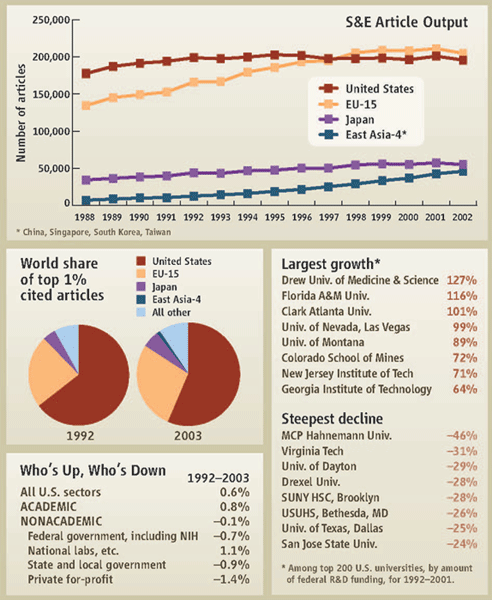|
News & Views item - November 2007 |
![]() U.S. Scientists Fall Behind Europe in Publication Numbers but Retain
Citations Lead. (November 11, 2007)
U.S. Scientists Fall Behind Europe in Publication Numbers but Retain
Citations Lead. (November 11, 2007)
It's old news but has its interests not least the comments from Science readers.
 |
|
Credit: Science, Source NSF, Division of Science Resources Statistics 2007 |
In the August 3, 2007 issue of Science Jeffrey Mervis described: "A new study by the National Science Foundation (NSF) showing that the overall number of publications by U.S. scientists has remained flat for more than a decade calls to mind the opening words of a classic 1960s folk rock anthem: 'There's something happening here; what it is ain't exactly clear.'"
Mr Mervis goes on, "Despite the continued expansion of the peer-reviewed literature, the total output of U.S. scientists stopped growing in the early 1990s and hasn't budged since then. The pattern, which cuts across all disciplines, reverses decades of steady expansion and leaves NSF officials scratching their heads for an explanation."
Now the writers of two letters in this week's issue of the journal (November 9, 2007) give their assessments.
John P. Moore Department of Microbiology and Immunology Weill Medical College Cornell University, New York can't understand why the NSF thinks there's a conundrum:
I was amazed by J. Mervis's News of the Week story "U.S. output flattens, and NSF wonders why" (3 August, p. 582). Not by the conclusion that U.S. science productivity is flattening out, but because apparently nobody interviewed by the NSF could identify the reason. Had the question been posed of almost any working scientist I know, the simple and accurate answer would have been that the number of papers that are written is diminishing because scientists are able to spend less time writing papers! Instead, we spend ever-more time on the increasingly burdensome administrative requirements of conducting science legally, and on writing, rewriting, and re-rewriting grant applications as the NIH's pay line drops to catastrophically low levels. As the number of hours in a day is finite and unchanging, something has to give. If I didn't have to spend the rest of this month ignoring various half-complete manuscripts and rewriting a grant application, I'd be able to explain in more detail.
Rickye S. Heffner, Department of Psychology, University of Toledo, Ohio in part had this to say:
The regulatory burden that accelerated around 1990 is finally affecting the output of U.S. researchers. Increased funding is reduced by the cost of regulatory compliance: expensive security systems for animals, superfluous accreditation, excessive requirements for cage sterilization, verification of sterility using cultures, and signatures at every step. And, of course, the regulatory documentation takes time away from documenting the research itself. Because of the monumental effort required to gain approval to use animal or human subjects in research, discouraged investigators avoid pursuing experiments that require new approvals, even if the idea may take only a few days to test... Science is an exploration of the unexpected, and these constraints are suffocating.
Who knows this may give Australian university employed researchers the joy of Schadenfreude by helping to drag US research back and at least partially leveling the playing field.
Comes RQF of course and the gap will return to its "normal" widening canyon.